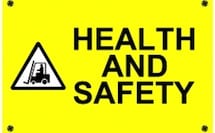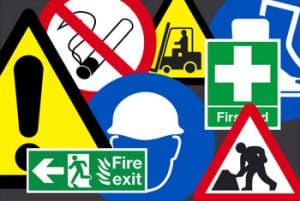If you want to work within the United Kingdom Construction industry, you must first take and pass the Health and Safety Information CSCS test. This test is a computer-based, multiple choice, health, a safety and environment test. It assesses whether or not you have the knowledge and qualifications needed to work safely within the area you have chosen. It is designed with the intention of improving the awareness of health and safety concerns in order to not only reduce accidents but reduce the number of injuries and deaths that occur on construction sites as well. The following information is essential information that you should know, relating to general health and safety concerns, in order to successfully pass the CSCS test.
Personal Protective Equipment: What it is and Where to Find it
PPE, or personal protective equipment, is equipment and clothing alike that is designed with the intention of keeping employees safe from potential, or obvious, hazards found on the work site. The United Kingdom requires employers to legally provide employees with the personal protective equipment needs to carry out their jobs in a safe manner. If there is a reason you must source your own personal protective equipment, the United Kingdom sites contain numerous retail providers that specialise in this area.
Why is PPE important?
Personal protective equipment is there to keep workers safe and protected while they carry out their jobs. Construction sites are seen as high-risk worksites. This means that it is highly important that workers keep their personal protective equipment on correctly, always, while they are on the worksite. Personal protection equipment can protect employees from a number of different conditions. It can keep them safe from falling objects or long hanging surfaces. It can keep them out of contact with dangerous chemicals, dust, debris that are hazardous, and metal due to splashes. Personal protective equipment can also protect workers as they work in conditions providing poor levels of visibility, potential skin laceration, injuries to their feet and ankles, injuries from falling, hearing damage, and damage to their vision or eyes.
Basic Mandatory PPE
Construction sites are high risk, as mentioned above. Because of this, it is important that you never step on any worksite without wearing the mandatory Personal Protective equipment. The basic required equipment will be clothing that provides high visibility (jacket/vest), footwear designed to protect your feet, and a hard hat that is designed to protect your head. Most construction sites also require employees to wear safety gloves and goggles at all times as well.
Task Specific PPE
Mandatory personal protective equipment is not the only type of PPE you should be looking at. There are also a number of items that relate only to specific types of work or specific tasks that may be done while on the job. You can consult with the method statement in order to know what type of PPE is required for the job or task you are performing. The method statement is supposed to detail a safe system of work for the task at hand, and this includes a list of the PPE needed to carry out the job safely and in line with the procedures on site. If you are unsure about anything regarding specific PPE, you must inquire with your line manager, the supervisor on site, or a health and safety representative so that they can clarify whatever is causing your confusion. Task-specific PPE us things such as Respirators, safety goggles, heat proof clothes, harnesses, hearing protection, or specialised clothing (such as overalls or heat-proof clothing).
Maintaining and Storing PPE
It is the employer’s responsibility to provide employees with PPE, but it is the employee’s responsibility to take care of their personal protective equipment and ensure that it is stored correctly when not in use. If any of your personal protection equipment is damaged, you are required to immediately request a replacement. You should never try to change your PPE, it is designed specifically to keep you safe and any changes you make can affect its ability to keep you safe. You should ensure that your PPE is stored in a safe, dry area where it is safe from impairment and any type of exposure to extreme temperatures. You should do everything possible to avoid damaging the PPE that is more fragile by nature, such as your safety glasses and make sure that you place smaller, more fragile, items in a container before storing them.
First Aid on the Jobsite
Personal protective equipment is not the only thing on the job site designed to keep you safe. It is required that all construction sites contain a first aid box or a first aid station that is equipped in order to adequately handle the number of workers found on the job site. There also must be one employee that is the “appointed first aider” This person will take charge of any and all first aid arrangements and distribute first aid care when called for. Finally, each construction site is required to provide information that informs the workers on the site of who is in charge of first aid and where they can find them.
You Can Typically Find the Following at a First Aid Station:
- Sterile dressing or bandages that are both large and small in size
- An assortment of plasters
- Dressings
- Swabs
- Wound wipes
- Eyewash pods
- Eyewash stations
- Tweezers
- Scissors
- Accident Book
- Blankets
- Gloves
- Braces
- Supports
- Boxes for the disposal of medical wastes
What is the First Aider and the Appointed Person and How many are on site?
A first aider is a person who has undertaken the training and has the required qualification in first aid that enables them to administer treatment to employees when it is required. A first aider found on a construction site is required to have a valid certificate in either First Aid at Work (FAW) or Emergency First Aid at Work (EFAW). An appointed person is not required to have training in first aid. They simply monitor the equipment and contact medical professionals or emergency services when required. A site that contains less than five employees is only required to have an appointed person on site. However, if a site contains five or more employees, they must have a first aider on site for every fifty workers.
Basic Information Regarding the Management of Your Health While at Work
The construction industry, due to the nature of the work itself, can neglect or disregard the concept of occupational health. The construction industry, because of its high-risk nature, tends to focus on accident prevention more than managing occupational health. This is because most of the accidents that are associated with work done on a construction site relate to serious injury. It is just as important, however, to manage and control the continuous occupational risks threatening your overall health.
Sometimes, it can take a while to notice occupational health problems that have occurred. The consequences, even though harder to notice immediately than accidents, can have consequences that are just as harmful as the ones relating to accidents and can even cause long-term suffering.
Manual workers tend to be at risk for obtaining the following complications:
- Respiratory issues
- Hand-arm vibration syndrome
- Skin disease
- Weil’s disease
- Hearing loss due to excessive exposure to loud noise
- Musculoskeletal disorders that can be caused by manual handling
The employer is responsible for managing occupation risks and for providing employees with regular health checks and access to first aid facilities. Construction employees should also have access to both literature and training on procedures for health and safety and on how to prevent potential occupational health conditions.
The management and prevention of occupational issues should include sickness absence management, a policy for returning to work, stress management strategies, and health surveillance. The health and safety advisor on site, or your employer, is responsible for making sure that you remain protected from both occupational risks and hazards. You can become a healthier and safer working through ensuring that you care for your own safety whenever possible and by obtaining additional training, information and literature on the avoidance of occupational hazards whenever you can. Taking the CSCS test and applying for the card proves that you have the knowledge you need to carry out your job safely.
Safety Signs
There are three main types of safety signs. The first is the sight that simply reminds workers to take the appropriate health and safety precautions before they enter a specific worker site. The second is the signs that warn you are entering a dangerous area. Finally, the third signs warn workers that only authorised personnel may enter a specific area. Safety signs are colour coded. Red signs mean an area is restricted, blue signs mean you need some type of Personal protective equipment before you entire the area, and yellow signs provide you with a general warning about the area.



When safety signs are being placed on the worksite, it is important to remember that the location of the sign has a huge part in how effective it will be. Normally, multipurpose signs will be posted at all entry points to the work site. A multipurpose signs details all of the hazards found within the worksite and the PPE required. It also warns against unauthorised entry. In order to keep the worksite as safe as possible, warning signs with a single message should be placed throughout the site within the appropriate areas.
Everyone is Responsible for Safety
Both the employer and the employee are legally responsible for health and safety on the worksite. Both are responsible for following the procedures that are put in place in order to ensure the worksite remains as safe as it possibly can. Construction work comes with numerous hazards and risks. Because of this, construction workers must go through a number of health and safety courses in order to train them on their legal obligations regarding health and safety at the workplace. Occupational risks are minimised when simple safety precautions are put into place and followed appropriately.






